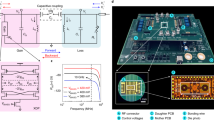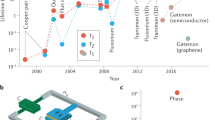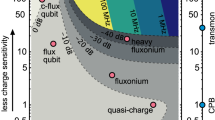Abstract
Clock distribution is central to digital technology and influences circuit performance, interconnect overhead and efficiency. However, ensuring reliable clock distribution across large digital systems with low skew and jitter—and in the presence of device variations and thermal noise—is a design challenge. Here we report a superconducting metamaterial resonant clock network that can provide energy-efficient power delivery to large superconducting digital systems. The resonant clock network is based on a metamaterial design with an infinite-wavelength zeroth-order resonance mode and utilizes the ultralow Joule loss of superconductors at microwave frequencies. With this approach, we perform S-parameter measurements for a 10 GHz design and validate a digital reciprocal quantum logic circuit with 48,000 junctions operating at 3.5 GHz. The network supports uniform power distribution with less than 1 dB variation across a 3 × 3 mm2 active chip area and around 30% power efficiency. Static power dissipation is 28 μW, which is similar to that of active devices.
This is a preview of subscription content, access via your institution
Access options
Access Nature and 54 other Nature Portfolio journals
Get Nature+, our best-value online-access subscription
$29.99 / 30 days
cancel any time
Subscribe to this journal
Receive 12 digital issues and online access to articles
$119.00 per year
only $9.92 per issue
Buy this article
- Purchase on Springer Link
- Instant access to full article PDF
Prices may be subject to local taxes which are calculated during checkout




Similar content being viewed by others
Data availability
The data that support the findings of this study are available from the corresponding author upon reasonable request.
References
Xiu, L. Clock technology: the next frontier. IEEE Circuits Syst. Mag. 17, 27–46 (2017).
Chueh, J., Sathe, V. & Papaefthymiou, M. C. 900MHz to 1.2GHz two-phase resonant clock network with programmable driver and loading. In IEEE Custom Integrated Circuits Conference 2006 777–780 (IEEE, 2006).
Hansson, M., Mesgarzadeh, B. & Alvandpour, A. 1.56 GHz on-chip resonant clocking in 130nm CMOS. In IEEE Custom Integrated Circuits Conference 2006 241–244 (IEEE, 2006).
Jana, R. K., Snider, G. L. & Jena, D. Energy-efficient clocking based on resonant switching for low-power computation. IEEE Trans. Circuits Syst. I: Regul. Pap. 61, 1400–1408 (2014).
Sathe, V. S. et al. Resonant-clock design for a power-efficient, high-volume x86-64 microprocessor. IEEE J. Solid-State Circuits 48, 140–149 (2013).
Kuttappa, R., Taskin, B., Lerner, S. & Pano, V. Resonant clock synchronization with active silicon interposer for multi-die systems. IEEE Trans. Circuits Syst. I: Regul. Pap. 68, 1636–1645 (2021).
Herr, Q. P., Herr, A. Y., Oberg, O. T. & Ioannidis, A. G. Ultra-low-power superconductor logic. J. Appl. Phys. 109, 103903 (2011).
Takeuchi, N., Ozawa, D., Yamanashi, Y. & Yoshikawa, N. An adiabatic quantum flux parametron as an ultra-low-power logic device. Supercond. Sci. Technol. 26, 035010 (2013).
Likharev, K. K. & Semenov, V. K. RSFQ logic/memory family: a new Josephson-junction technology for sub-terahertz-clock-frequency digital systems. IEEE Trans. Appl. Supercond. 1, 3–28 (1991).
Vernik, I., Kirichenko, A., Mukhanov, O. & Ohki, T. Energy-efficient and compact ERSFQ decoder for cryogenic RAM. IEEE Trans. Appl. Supercond. 27, 1–5 (2016).
Herr, A. Y. et al. An 8-bit carry look-ahead adder with 150 ps latency and sub-microwatt power dissipation at 10 GHz. J. Appl. Phys. 113, 033911 (2013).
Oberg, O. T., Herr, Q. P., Ioannidis, A. G. & Herr, A. Y. Integrated power divider for superconducting digital circuits. IEEE Trans. Appl. Supercond. 21, 571–574 (2010).
Bin, M., Gaidis, M., Zmuidzinas, J., Phillips, T. & LeDuc, H. Low-noise 1 THz niobium superconducting tunnel junction mixer with a normal metal tuning circuit. Appl. Phys. Lett. 68, 1714–1716 (1996).
Ricci, M., Orloff, N. & Anlage, S. M. Superconducting metamaterials. Appl. Phys. Lett. 87, 034102 (2005).
High, A. A. et al. Visible-frequency hyperbolic metasurface. Nature 522, 192–196 (2015).
Coulais, C., Sounas, D. & Alù, A. Static non-reciprocity in mechanical metamaterials. Nature 542, 461–464 (2017).
Rabinovich, M. I. & Trubetskov, D. I. Oscillations and Waves: in Linear and Nonlinear Systems, Mathematics and its Applications (Soviet Series) Vol. 50, Ch. 4 (Kluwer Academic Publishers, 1989).
Park, J., Ryu, Y., Lee, J. & Lee, J. Epsilon negative zeroth-order resonator antenna. IEEE Trans. Antennas Propag. 55, 3710–3712 (2007).
Sanada, A., Caloz, C. & Itoh, T. Novel zeroth-order resonance in composite right/left-handed transmission line resonators. In Proc. Asia-Pacific Microwave Conference 3, 1588–1591 (2003).
Khanna, A. & Garault, Y. Determination of loaded, unloaded, and external quality factors of a dielectric resonator coupled to a microstrip line. IEEE Trans. Microw. Theory Techn. 31, 261–264 (1983).
Talanov, V. V., Mercaldo, L. V., Anlage, S. M. & Claassen, J. H. Measurement of the absolute penetration depth and surface resistance of superconductors and normal metals with the variable spacing parallel plate resonator. Rev. Sci. Instrum. 71, 2136–2146 (2000).
Egan, J. et al. Synchronous chip-to-chip communication with a multi-chip resonator clock distribution network. Preprint at https://arxiv.org/abs/2109.00560 (2021).
Berkley, A. et al. A scalable readout system for a superconducting adiabatic quantum optimization system. Supercond. Sci. Technol. 23, 105014 (2010).
Herr, Q. P. A high-efficiency superconductor distributed amplifier. Supercond. Sci. Technol. 23, 022004 (2010).
Egan, J., Brownfield, A. & Herr, Q. True differential superconducting on-chip output amplifier. Supercond. Sci. Technol. 35, 045018 (2021).
Pozar, D. M. Microwave Engineering 2nd edn (John Wiley & Sons, 2012).
Acknowledgements
We acknowledge the valuable conversation with O. Naaman regarding the clock network design. H. Dai and J. Egan assisted with the physical design of the clock network and functional circuits. J. Goodman and M. Lateef assisted with the microwave measurement. D. Harvey assisted with the circuit design. This research is based on the work supported in part by the ODNI, IARPA, via ARO, contract no. W911NF-14-C-0116. The views and conclusions contained herein are those of the authors and should not be interpreted as necessarily representing the official policies or endorsements, either expressed or implied, of the ODNI, IARPA, or the US Government.
Author information
Authors and Affiliations
Contributions
J.A.S. and V.V.T. conceived the idea, performed the analysis and wrote the manuscript. M.E.N. performed the electrical and physical design and modelling, as well as conceived several design improvements. A.C.B. and N.B. performed the measurements and analysed the data. A.Y.H. and Q.P.H. initiated and supervised the work.
Corresponding author
Ethics declarations
Competing interests
All authors are or have been employed by Northrop Grumman Corp., which holds several patents relating to work discussed herein. See U.S. Patents 10,591,952; 10,884,450; 10,474,183; 10,461,867; 10,133,299; 9,722,589.
Peer review
Peer review information
Nature Electronics thanks Nobuyuki Yoshikawa and the other, anonymous, reviewer(s) for their contribution to the peer review of this work.
Additional information
Publisher’s note Springer Nature remains neutral with regard to jurisdictional claims in published maps and institutional affiliations.
Rights and permissions
About this article
Cite this article
Strong, J.A., Talanov, V.V., Nielsen, M.E. et al. A resonant metamaterial clock distribution network for superconducting logic. Nat Electron 5, 171–177 (2022). https://doi.org/10.1038/s41928-022-00729-7
Received:
Accepted:
Published:
Issue Date:
DOI: https://doi.org/10.1038/s41928-022-00729-7
This article is cited by
-
Extremely large area (88 mm × 88 mm) superconducting integrated circuit (ELASIC)
Scientific Reports (2023)
-
Mechanical metamaterials and beyond
Nature Communications (2023)



